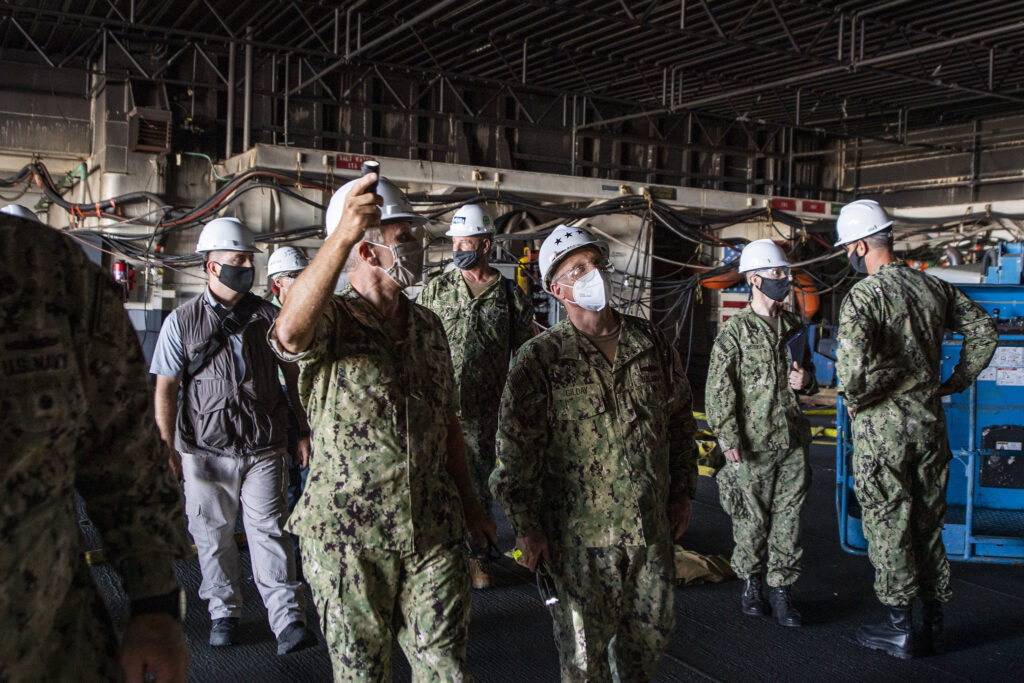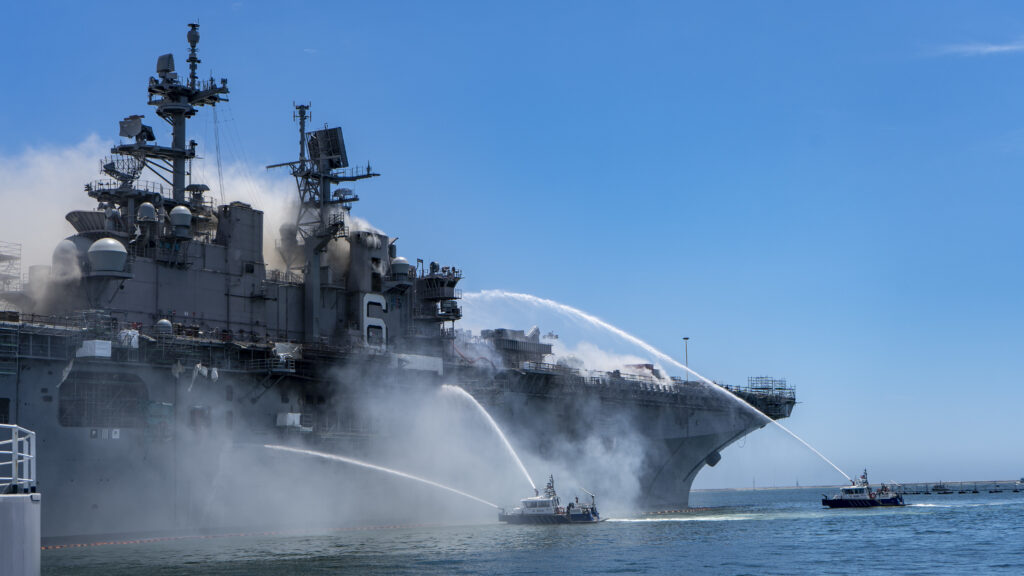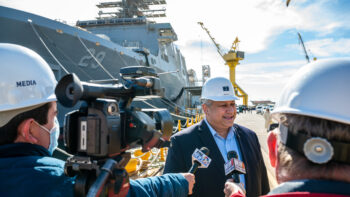
Chief of Naval Operations Adm. Mike Gilday, right, walks through the USS Bonhomme Richard
WASHINGTON: The USS Bonhomme Richard suffered fire and water damage on 11 of its 14 decks, with damage “nearly encompassing the 844 ft length and 106 ft beam of the ship,” the Navy’s top admiral said in an email to his fellow admirals and Master Chiefs Wednesday. Chief of Naval Operations, Adm. Michael Gilday, has said he thinks the amphibious ship — designed to carry Marines, helicopters, and planes like the F-35B — could be repaired, but that it might more cost-effective to replace it.
The internal note provided Gilday’s first unvarnished assessment of the damage to the vessel, which burned for four days last week while pierside in San Diego.
“I walked sections of the ship 5 levels below and had the opportunity to examine the superstructure,” the admiral said in the email obtained by Breaking Defense. “The island is nearly gutted, as are sections of some of the decks below… nearly encompassing the 844 ft length and 106 ft beam of the ship….[and] sections of the flight deck are warped/bulging.”
It won’t be clear what the future holds for Richard for some time. It was undergoing a long-planned upgrade that would allow it to operate with the new F-35B jump jets instead of the aging AV-8B Harrier, making it just the fifth Navy ship to do so.
Gilday noted out that the Naval Sea Systems Command is still conducting a full assessment of the ship.
The exact cause of the fire is a primary concern of investigators, but Gilday noted it appears “the fire started in the lower vehicle storage area — 6 decks below the flight deck and near the middle of the ship – spreading aft, forward, and up.”
Early assessments point to two main factors that contributed to the speed with which the fire spread through the ship: wind whipping through the well deck, and explosions, one of which was heard 13 miles away.
“The explosions, some were intense, and the uncertainty of their location and timing, led to a situation, that might have been under control late Sunday night, but expanded into a mass conflagration,” he wrote, “spreading quickly up elevator shafts, engine exhaust stacks, and through berthing and other compartments where combustible material was present. There were likely other contributing factors, but I won’t speculate on that.”

USS Bonhomme Richard burns this week while docked in San Diego.
Gilday formed his observations on a trip to San Diego last Friday, where he spoke to reporters after going aboard the stricken ship. He acknowledged that he toured several decks where he saw extensive damage. While he insisted he is “100 percent confident that our defense industry can put this ship back to sea,” he also questioned whether the investment in the 22 year-old ship would be worth it.
But as he did in his press conference on Friday, Gilday told his admirals and chiefs that he was proud of the federal and Navy firefighters who extinguished the blaze.
“They had experienced the intense, inferno-like heat,” that rose to as high as 1,200 degrees fahrenheit. “The dark smoke that obscured the view of teammates by their side, and the explosions – the latter had to be like a mine field … unknown when and where, and how severe, those blasts might be. Some had been knocked down by these blasts – some, more than once – but they got up, re-focused, and re-attacked.”
The Navy has come under fire over the last several years for having deep-seated cultural problems that have led to a series of disasters and leadership failures.
The dual collisions in 2017 that cost the lives of 17 sailors aboard the destroyers USS Fitzgerald and McCain have remained top of mind for Navy leadership since the tragedies, and led to reforms in training and crew rest. Over the past year the resignations of two Navy secretaries — Richard Spencer and Thomas Modly — after clashes with the White House and the mishandling of the COVID outbreak aboard the USS Theodore Roosevelt have further dented the service’s standing.
New secretary Kenneth Braithwaite has said fixing the Navy’s culture is his highest priority, and Gilday has struck the same note in recent days.
Gilday noted that every firefighting team to go aboard the Richard was led by sailors from the ship, “no question, this was THEIR ship and they would walk point on every firefighting mission. Most had to be ordered … and re-ordered … to go home at some point and get some rest.”
He added that changes in training since the dark days of the Fitzgerald and McCain took hold in fighting the fire, and “what I saw in San Diego is inextricably linked to those formative weeks of training at Great Lakes” and “was tested on BONHOMME RICHARD.”
Lockheed, Howmet settle lawsuit over F-35 titanium (EXCLUSIVE)
Lockheed Martin alleged in court filings that Howmet cut off the supply of titanium after the aerospace giant refused to agree to higher prices, threatening production of the F-35.


























